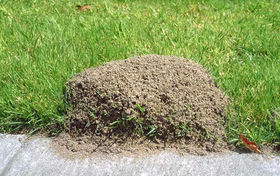Ants
It is not the ants that are a problem, mostly their anthills that are like mini mole hills across the lawn. Ants prefer living in dry light soils and are capable of shifting a large proportion of soil onto the lawn's surface, causing havoc with the mower as these raised areas will get easily 'scalped' by the action of mowing.
We always hear horror stories of lawn owners pouring boiling water over the anthills with the net result of dead patches of grass where the hot water scalded and then killed the grass plants.
The UK species of red and yellow ants are mainly carnivorous and are generally only an outdoor problem. Black ants however, are a species of sweet eaters; their natural food being honeydew, a secretion from aphids (greenfly, blackfly and whitefly) and other plant sap eating insects
Ants can cause concern but they are a nuisance rather than destructive pests. They feed mainly on insects, including other ants. They also look for the sweet liquid known as honeydew, which is excreted by aphids and some other sap-feeding insects.
Damage
Ants can protect aphids from attack by ladybirds and other predators in order to secure their supply of honeydew. Increased numbers of aphids may result in more damage to plants. However, ants do little damage to plants themselves, except by disturbing soil around plant roots and depositing it on the surface during their nest building activities.
Control
Unless their nests are particularly troublesome, ants are best left alone. If a colony is destroyed it is likely that its place will be taken by incoming queen ants, which take over the territory and establish new nests. Disperse ant heaps on lawns by brushing the excavated soil on a dry day before the lawn is mown, otherwise the soil will get smeared on the lawn surface by the mower. If the lawn has an uneven surface due to years of ant activity, peel back the turf in the raised areas, remove excess soil and relay the turf. This is easier to do in the winter when ants are less active.
There is not a lot you can really do about ants in your lawn, except get a bit mad and go blue in the face. Raise the mower setting and pick a nice dry day and scatter the anthills with a besom broom or a stiff garden broom just ahead of mowing. You could control the ants in your pathways and building lines and try and prevent them getting to your lawn in the first place - a case of prevention is better than cure.
To make a real impression on ant numbers it would be necessary to destroy the nests rather than just the foraging ants. That is difficult to achieve as ant nests occupy a much larger volume of soil than might be suggested by the small heaps of soil excavated on to the surface.
A pathogenic nematode, Steinernema feltiae, is available from some mail order suppliers of biological controls for treating ant nests in lawns and flower beds. The microscopic worm-like nematodes are watered into the soil in places where ants are bringing soil up onto the surface.

 Delivery
Delivery Basket
Basket Checkout
Checkout How will my items be
delivered?
How will my items be
delivered?
 How to keep my lawn
healthy?
How to keep my lawn
healthy?










